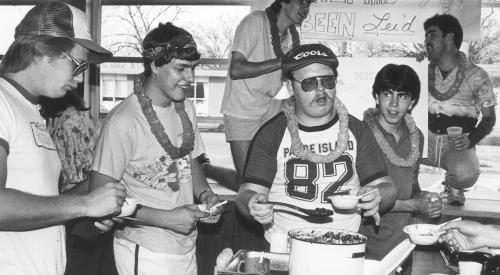|
Eric Wittenberg is a third-generation builder and a student of the work hard, play hard school. When he relocated from Southern California to Colorado about five years ago, he left behind his scuba gear, but held on to a personal debt of gratitude for those who helped guide him along the way.
 |
Personal and business mentors are one in the same for Wittenberg. He owes much to his father, a builder, for making him "who I am today." He credits the founders of the Fieldstone Company (now the Fieldstone Group of Companies) with giving him "the best foundation I could have ever possibly had, and showed me what it means to be part of a values-driven company." He calls former boss, Bob Albertson, "a key individual who set an example with his guidance and his people-orientated [skills]" in running a division of Presley Homes (now part of William Lyon Homes) in Southern California.
Timing Isn't EverythingAfter a short time with KB Home in Denver, Wittenberg signed on with McStain Neighborhoods in June 2001 and became chief executive officer within two years, succeeding founders Tom and Caroline Hoyt. The economic downturn had hurt Denver particularly hard and while other mid-sized builders sold to national publics, Tom Hoyt was committed to keeping the company private.
Upon meeting Hoyt, he was encouraged by this man who "felt that what McStain stood for was far too important to sell and risk having it go away." Wittenberg was also impressed that Hoyt put his money where his mouth was, agreeing to accept the extended payout of an employee stock ownership plan over a quick sellout windfall.
"If you're coming into an existing company that doesn't have that kind of foundation, it's hard to ingrain that in existing employees," he says. "Those kinds of foundations are hard to produce."
Denver was particularly challenging for builders. Denver's major investment in a high-tech Internet and telecom corridor was collapsing. Equally tough, Denver appears to lead the nation as a market dominated by national publics, who account for 70 percent of all housing there.
The opportunity would give Wittenberg the chance to reverse a past failure. In the early 1990s recession, he struggled for three years before shuttering his own building startup.
"How's that for timing?" he says of his 2001 arrival at McStain, noting that 20 percent of the market "disappeared overnight." The organization fared better than many, dropping 14 percent in 2001 sales and bouncing back with record highs in 2002 and 2003. Last year, however, sales dropped roughly $1 million. Wittenberg says profits held but sales dipped due to a necessary land constraint; he had to retool McStain's land inventory and divest non-strategic acreage.
This year, he is projecting a record $120 million in sales on 400 closings — 30 percent ahead of plan. The growth is a result of a new era of brand definition. McStain has refined an identity in the green building and smart-growth area, which is a reputation the Hoyts — now serving as non-executive advisors — initiated.
 |
To stay on that cutting edge, Wittenberg has been busy "institutionalizing innovation" by replacing intuitive processes with formalized programs to operate more efficiently. He has driven an intensive market research program that has uncovered the following knowledge about the buyers seeking McStain:
- They are higher in income and willing to trade square footage for a higher level of design. In response, McStain is increasing move-up homes in the product mix and paying more attention to higher design in smaller footprints; over five years, attached housing was increased from 50 to 60 percent in the product mix.
- They are more educated and have greater informational demands. Wittenberg says the company has formalized a program to educate buyers on "the thought that goes into every McStain house," from construction materials to indoor air quality and embedded environmental programs.
- They are more cause-oriented, with a community voluntarism rate more than twice the national average. McStain is a local and national champion of green building and smart growth, with numerous local and national awards.
- They are primarily resale home buyers turned off by mainstream production communities. McStain's outreach to local realtors now brings in 65 percent of unit sales. Further research has led to a major land strategy to address this buyer preference, as well.
McStain's research points to a group of target buyers who want more mixed-use neighborhoods with pedestrian-friendly access to culture and shopping. McStain is moving to build such neighborhoods from scratch or locate communities near existing communities bearing those amenities.
It's largely, but not exclusively, infill because while avoiding what Wittenberg loosely dubs "fringe" locations or "the Wal-Mart zone," he still welcomes greenfields that suit buyer preferences. As the company's focus shifts from outer-ring prairies on the fringe, the less competition it faces from the national publics who build in those locations — and whose buyers are not McStain's buyers.
"Our brand starts with our locations," Wittenberg says, "and what land we buy can erode our brand or build on it." He notes that McStain can't match the national publics in terms of access to capital, economies of scale or research and development resources, so differentiation is a natural path. And he wants to do that "so completely that not only do our buyers know we're different, but the land owners know we're different, too. We want them to come to us when they care what gets built on their land."
Wittenberg now turns his attention toward accelerating this intensification with three new McStain-sized master plans ranging from 250 to 600 units. All three will come online in 2006 with closings in 2007, so, he says, "we're poised to take the next leap in our growth in terms of volume and revenues."
The evolution has begun. Wittenberg sees the company's proportion of move-up buyers hitting 80 percent in 2007, up from approximately 60 in 2004. And at 200 units point, Wittenberg says it will be time for McStain to move into new markets. "I could buy land here all day long if all I wanted to do was build houses and make money. But I think there are other markets that are very conducive to our brand and what we do, and I'd like to take McStain's show on the road."
| |||||||||||||||||||||||||||||||||||||












